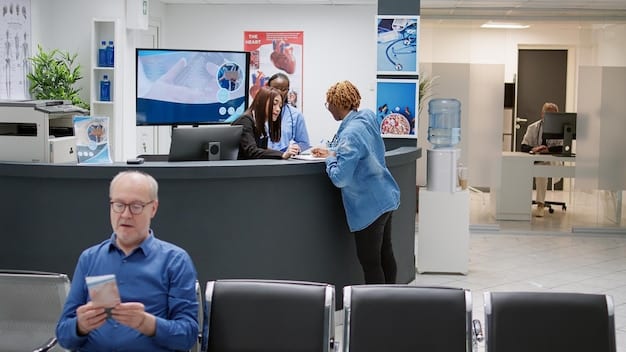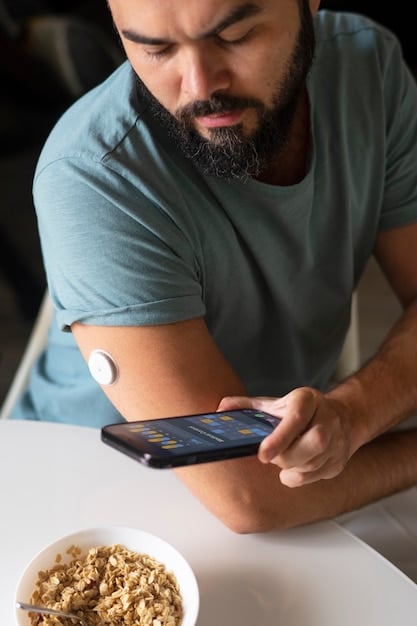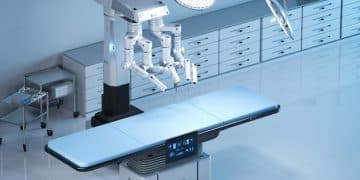Telehealth Expansion: Remote Patient Monitoring Opportunities in US

The recent $5 billion expansion in telehealth funding presents significant opportunities for the widespread adoption and advancement of remote patient monitoring (RPM) technologies across the United States healthcare landscape, promising enhanced patient outcomes and operational efficiencies.
The landscape of healthcare delivery is undergoing a profound transformation, driven by technological innovation and evolving patient needs. At the forefront of this shift is the burgeoning field of telehealth, which has received a substantial financial injection that promises to redefine patient care. This notable investment presents a critical juncture, particularly for the widespread adoption of remote patient monitoring (RPM). The implications of The $5 Billion Telehealth Expansion: Opportunities for Remote Patient Monitoring in the US are vast, signaling a new era for accessible, efficient, and proactive healthcare.
The Genesis of Telehealth’s Accelerated Growth
The rapid acceleration of telehealth was largely an unforeseen consequence of global health crises, yet its foundational principles have been evolving for decades. Initially viewed as a supplement, or a niche service for geographically isolated populations, telehealth has rapidly ascended to become a cornerstone of modern healthcare delivery. Its ability to bridge distances and provide care continuity in challenging circumstances proved invaluable, underscoring its inherent resilience and adaptability.
This unprecedented growth, fueled by both necessity and demonstrated efficacy, has attracted significant investment, most notably the $5 billion expansion directly earmarked for enhancing telehealth capabilities across the United States. This substantial funding is not merely a quantitative increase; it represents a qualitative shift in policy and perception, moving telehealth from the periphery to the mainstream. Stakeholders across the healthcare continuum, from providers to insurers and technology developers, are now aligning their strategies to leverage this new influx of capital effectively.
Policy Shifts and Reimbursement Parity
A critical enabler of this expansion has been the evolution in healthcare policy, particularly concerning reimbursement parity. Historically, one of the primary impediments to telehealth adoption was the lack of equitable payment for virtual services compared to in-person care. The recent regulatory changes, often enacted with urgency, have largely addressed this disparity, providing financial incentives and stability for providers to integrate telehealth into their standard operational procedures.
- Medicare and Medicaid Flexibility: Expanded coverage for a wide array of telehealth services, including audio-only visits.
- Cross-State Licensing Waivers: Temporary measures that allowed practitioners to provide care across state lines, improving access.
- Private Payer Alignment: Many commercial insurers followed federal lead, adapting their policies to cover virtual care.
These policy shifts are invaluable because they create a sustainable financial model for telehealth. Without clear and consistent reimbursement, even the most innovative technologies struggle to gain traction in a cost-conscious healthcare environment. The funding expansion, combined with these policy realignments, creates a fertile ground for technologies like remote patient monitoring to flourish, ensuring that investments translate into tangible improvements in patient care and operational efficiency.
As the healthcare system continues to evolve, the initial drivers of telehealth’s rapid expansion are likely to solidify into permanent fixtures. The demonstrated benefits in terms of patient access, convenience, and reduced healthcare costs are compelling arguments for its continued prominence. The $5 billion injection provides the necessary impetus to refine and scale these services, pushing the boundaries of what is possible in digital health.
Remote Patient Monitoring: A Catalyst for Proactive Care
Within the broader spectrum of telehealth, remote patient monitoring (RPM) stands out as a transformative technology with the potential to fundamentally reshape how chronic conditions are managed and how preventative care is delivered. RPM involves the use of digital technologies to collect medical and other forms of health data from individuals in one location and electronically transmit that information securely to healthcare providers in a different location for assessment and recommendations. This continuous stream of data allows for a more dynamic and responsive approach to patient health, moving beyond episodic care to a model of continuous oversight.
The true power of RPM lies in its ability to enable proactive care. Instead of waiting for a patient’s condition to deteriorate to the point of requiring an emergency room visit or hospitalization, RPM systems can alert providers to subtle changes in vital signs, symptoms, or other biometric data. This early detection capability allows for timely interventions, potentially preventing adverse events and improving long-term health outcomes. For patients with chronic diseases such as diabetes, hypertension, or heart failure, RPM offers a lifeline, providing consistent support and peace of mind.
Common RPM Devices and Applications
The array of devices used in RPM is diverse and continually expanding, reflecting the varied needs of different patient populations and conditions. These devices range from simple, consumer-grade wearables to sophisticated, medical-grade sensors, all designed to capture relevant health metrics from the comfort of the patient’s home.
- Blood Pressure Monitors: Regularly track hypertension and assess the effectiveness of medication regimens.
- Continuous Glucose Monitors (CGMs): Provide real-time insights into blood sugar levels for diabetes management.
- Pulse Oximeters: Measure oxygen saturation, crucial for respiratory conditions like COPD and asthma.
- Weight Scales: Monitor fluid retention in congestive heart failure patients.
- ECG Devices: Track heart rhythm irregularities for cardiac patients.
Beyond individual devices, integrated RPM platforms aggregate this data, often incorporating artificial intelligence and machine learning to identify trends, flag anomalies, and provide actionable insights to clinicians. This holistic approach ensures that data is not just collected but is also intelligently analyzed and presented in a format that supports efficient clinical decision-making. The investment in telehealth directly bolsters the development and deployment of these sophisticated RPM ecosystems, enabling their broader application.
The applications for RPM span a wide range of use cases beyond chronic disease management. It can be used for post-operative care, allowing patients to recover at home while still receiving professional oversight. It’s also increasingly vital in managing elderly populations, enabling them to age in place with greater safety and independence. The proactive nature of RPM systems is undoubtedly their greatest strength, transforming healthcare from a reactive response to illness into a continuous journey of health maintenance and disease prevention.

The $5 Billion Impact: Funding Streams and Strategic Priorities
The allocation of $5 billion towards telehealth expansion is a landmark decision that will reverberate throughout the US healthcare system. This isn’t just about bolstering existing services; it’s about catalyzing innovation, improving infrastructure, and ensuring equitable access to digital health solutions. Understanding the specific funding streams and strategic priorities associated with this significant investment is crucial for appreciating its potential impact, particularly on the scaling of remote patient monitoring initiatives.
The funding is typically channeled through various mechanisms, including grants, demonstration projects, and enhanced reimbursement policies. These diverse avenues ensure that resources are broadly distributed and targeted towards areas of greatest need and potential impact. A significant portion is expected to support the technological backbone required for robust telehealth services, including secure data transmission, interoperability between systems, and the development of intuitive user interfaces for both patients and providers.
Key Investment Areas for RPM
While the $5 billion is for general telehealth expansion, several areas are particularly pertinent to the growth of RPM:
- Infrastructure Development: Funding will support the expansion of broadband internet access in underserved and rural areas, which is critical for reliable RPM data transmission.
- Technology Acquisition and Integration: Aid for healthcare systems to acquire advanced RPM devices, software platforms, and integrate them with existing Electronic Health Records (EHRs).
- Workforce Training: Investment in training healthcare professionals to effectively utilize RPM technologies, interpret data, and manage virtual patient interactions.
- Research and Development: Support for innovation in new RPM devices, AI-driven analytics, and personalized care pathways based on collected data.
Beyond the direct financial injection, this funding signifies a strong governmental endorsement of telehealth as a permanent, integral component of healthcare. This endorsement encourages private sector investment, fostering a collaborative ecosystem where public and private entities work together to push the boundaries of digital health. For RPM, this means accelerated development of more sophisticated sensors, more accurate predictive analytics, and seamless integration into routine clinical workflows.
Strategic priorities tied to this funding emphasize not just the volume of telehealth services but also their quality, equity, and sustainability. There’s a strong focus on reaching vulnerable populations, ensuring that the digital divide does not exacerbate existing health disparities. This includes initiatives to provide patients with necessary devices and connectivity, alongside educational support to ensure they can confidently use RPM tools.
Ultimately, the $5 billion is a down payment on a future healthcare system that is more resilient, accessible, and personalized. For remote patient monitoring, it provides the runway necessary to move from promising innovation to widespread adoption, profoundly impacting how chronic diseases are managed, and how health is maintained across the US.
Overcoming Barriers and Ensuring Equitable Access
While the $5 billion telehealth expansion offers immense potential, the path to widespread and equitable adoption of remote patient monitoring is not without its challenges. Overcoming these barriers requires a multi-faceted approach, addressing technological, socioeconomic, and educational hurdles. Ensuring that the benefits of RPM reach all populations, especially those in underserved communities, is paramount to fulfilling its promise.
One of the most persistent challenges is the digital divide. Despite advancements in connectivity, many rural and low-income areas still lack reliable broadband internet access, which is essential for transmitting real-time patient data. Even where infrastructure exists, the cost of devices or data plans can be prohibitive for some individuals. These factors create significant access disparities, potentially widening health equity gaps rather than narrowing them.
Addressing Key Implementation Challenges
Effective implementation strategies must consider the diverse needs of the patient population and the capabilities of healthcare providers:
- Digital Literacy and Device Access: Initiatives to provide internet access, subsidized devices, and digital literacy training for patients are crucial.
- Interoperability and Data Security: Developing robust, secure platforms that seamlessly integrate RPM data with existing EHR systems while protecting patient privacy.
- Provider Burden and Training: Ensuring healthcare staff are adequately trained to manage an increased volume of data, interpret RPM insights, and effectively engage with patients virtually.
- Regulatory Clarity and Standardization: Establishing clear, consistent regulatory frameworks for RPM practices, device standards, and reimbursement across all states.
Furthermore, the shift to RPM requires a significant change in clinical workflows. Healthcare organizations need to reconfigure their operational models to effectively integrate continuous data streams into patient management. This includes developing clear protocols for data review, alert management, and timely intervention. Without proper training and support, the promise of RPM can quickly turn into an overwhelming burden for clinical staff.
Another crucial aspect is patient engagement. For RPM to be effective, patients must be willing and able to consistently use the monitoring devices and adhere to prescribed protocols. This necessitates user-friendly interfaces, clear instructions, and ongoing support to build patient confidence and compliance. Personalizing the RPM experience and demonstrating its tangible benefits to individual patients can significantly boost adoption rates.
Ultimately, the successful deployment of RPM at scale, supported by the $5 billion expansion, hinges on thoughtful planning and dedicated efforts to address these multifaceted barriers. It requires collaboration between policymakers, healthcare organizations, technology developers, and communities to build a truly inclusive and effective digital health ecosystem. The goal is not just to implement technology, but to leverage it to improve health outcomes for everyone, irrespective of their socioeconomic status or geographic location.
Integrating RPM into the Continuum of Care
The true power of remote patient monitoring is fully realized when it’s seamlessly integrated into the broader continuum of care, moving beyond isolated implementations to become a core component of patient management. This integration involves embedding RPM into existing clinical workflows, leveraging its data to inform treatment decisions across various care settings, and fostering closer collaboration between patients and their healthcare teams. The $5 billion telehealth expansion provides the impetus for healthcare systems to prioritize and strategically execute this integration.
Effective integration means that RPM data is not just collected but is actively used to inform primary care, specialist consultations, hospital discharge planning, and post-acute care. For instance, a patient with heart failure might have their weight and vital signs monitored daily via RPM. Any significant fluctuations could trigger an alert to their primary care provider, who might then adjust medication or schedule a timely virtual check-up, thereby preventing a costly emergency room visit. This proactive, data-driven approach enhances the efficiency and effectiveness of care delivery.
Strategic Areas for Seamless Integration
To fully integrate RPM, organizations must focus on several strategic pillars:
- EHR Integration and Interoperability: Ensuring RPM data flows directly and securely into the patient’s Electronic Health Record, making it easily accessible to all authorized providers.
- Clinical Workflow Re-engineering: Adapting existing clinic operations to incorporate RPM data review, alert management, and patient communication protocols.
- Care Team Collaboration: Fostering a collaborative environment where nurses, physicians, pharmacists, and allied health professionals can collectively monitor and respond to RPM insights.
- Patient Education and Empowerment: Educating patients on how their RPM data contributes to their care plan, empowering them to take an active role in their health management.
Moreover, integrating RPM facilities a “hospital-at-home” model, particularly for patients with conditions that traditionally require inpatient stays but can be safely managed remotely with continuous monitoring and intermittent in-person visits. This model reduces healthcare costs, minimizes hospital-acquired infections, and significantly improves patient satisfaction by allowing recovery in a familiar environment. The ability to safely monitor sicker patients remotely is a game-changer enabled by robust RPM capabilities.
The expansion also means that RPM can play a significant role in population health management. By aggregating data from large groups of patients, healthcare systems can identify trends, predict outbreaks, and tailor preventative interventions for entire communities. This macro-level application of RPM data allows for a more strategic allocation of resources and a more proactive approach to public health.
The journey towards full RPM integration within the continuum of care is complex, requiring sustained investment, technological sophistication, and a cultural shift towards proactive and patient-centric healthcare. The $5 billion funding represents a critical catalyst, providing the resources and momentum needed to make this vision a widespread reality, ultimately transforming the US healthcare landscape for the better.
The Economic and Health Outcomes of RPM Scalability
Scaling remote patient monitoring (RPM) capabilities, particularly with the support of the $5 billion telehealth expansion, promises significant economic and health outcomes. This is not merely about adopting new technology; it’s about fundamentally reshaping the cost structure of healthcare while simultaneously elevating the quality of patient care. The data consistently points to RPM as a financially astute and clinically effective solution for a multitude of chronic and acute conditions.
From an economic standpoint, RPM offers substantial cost savings by reducing reliance on more expensive episodes of care, such as emergency room visits and inpatient hospitalizations. By enabling proactive interventions and preventing condition exacerbations, RPM directly contributes to lower healthcare expenditures. For payers, including Medicare, Medicaid, and private insurers, this translates into reduced claims costs and a more sustainable healthcare delivery model. Providers can also benefit from optimized resource utilization and improved efficiency.
Key Benefits Realized from Scaled RPM
The widespread adoption of RPM yields tangible advantages across various facets:
- Reduced Hospitalizations and Readmissions: Early detection of deteriorating conditions prevents patients from needing acute care and cuts down on readmission rates for chronic conditions like heart failure and COPD.
- Lower Emergency Room Visits: Proactive management of symptoms and vital signs means fewer urgent, costly visits to the ER.
- Improved Patient Engagement and Self-Management: Patients who are actively involved in monitoring their health tend to be more adherent to treatment plans and lifestyle changes.
- Enhanced Clinical Efficiency: Healthcare providers can manage more patients with better insights, optimizing their time and resources.
- Better Chronic Disease Management: Continuous data helps in fine-tuning medication, diet, and exercise regimens, leading to better control of conditions and improved quality of life.
Beyond the direct financial ramifications, the health outcomes are equally compelling. Patients experience improved quality of life due to better disease control and fewer hospital stays. They gain a greater sense of autonomy and control over their health, often leading to higher satisfaction with their care. For clinicians, RPM provides a more complete picture of a patient’s health in their natural environment, allowing for more informed and personalized treatment strategies than periodic office visits alone.
For example, a study might reveal that a significant proportion of heart failure readmissions could have been prevented if patients had access to daily weight monitoring and early warning systems. Scaling RPM means that such interventions become commonplace, shifting the paradigm from reactive illness management to proactive health maintenance. This paradigm shift contributes to a healthier, more productive population, indirectly benefiting the economy through reduced absenteeism and increased workforce participation.
The $5 billion telehealth expansion is thus an investment not just in technology, but in a healthier and more financially sustainable healthcare future for the United States. Its impact on scaling RPM will be pivotal in demonstrating how innovative care models can deliver superior health outcomes at a more efficient cost. This dual benefit—economic viability and improved health—positions RPM as a cornerstone of modern healthcare reform.
Future Outlook: Innovations and Challenges Ahead
The trajectory for remote patient monitoring, propelled by the substantial $5 billion telehealth expansion, points towards a future teeming with innovation, yet also fraught with complex challenges. As RPM matures, it will undoubtedly integrate more sophisticated technologies, leading to more personalized, predictive, and pervasive healthcare solutions. However, navigating the evolving technological landscape, regulatory hurdles, and maintaining human connection in a digital world will be crucial.
Looking ahead, we can anticipate significant advancements in sensor technology, making devices smaller, less intrusive, and capable of monitoring an even wider array of physiological parameters. Wearable technology, especially, is poised to become even more ubiquitous, seamlessly integrating health monitoring into daily life without requiring conscious effort from the user. Artificial intelligence and machine learning will play an increasingly vital role in processing the vast amounts of data generated by RPM devices, identifying subtle patterns, predicting health events before they occur, and personalizing treatment recommendations with unprecedented accuracy.
Emerging RPM Trends to Watch
Several key trends are set to define the next generation of RPM:
- AI-Powered Predictive Analytics: Moving beyond just monitoring to actively predicting health deteriorations, allowing for hyper-personalized preventative interventions.
- Virtual Reality (VR) and Augmented Reality (AR) Integration: Exploring how these technologies can enhance patient education, rehabilitation, and even facilitate virtual visits with a more immersive experience.
- Genomic and Proteomic Integration: Combining RPM data with an individual’s genetic profile to offer truly precision medicine tailored to unique biological predispositions.
- Behavioral Health Integration: Expanding RPM to monitor stress levels, sleep patterns, and other indicators of mental well-being, fostering a holistic approach to health.
However, these innovations bring their own set of challenges. Data privacy and cybersecurity will become even more critical as more sensitive health information is collected and transmitted. Ensuring the interoperability of various devices and platforms will be essential to avoid fragmented patient data. Furthermore, as technology becomes more sophisticated, there’s a risk of exacerbating the digital divide if equitable access and comprehensive user support are not meticulously planned for.
Another significant challenge lies in maintaining the human element in healthcare. While technology enhances efficiency and insights, the empathetic connection between patient and provider remains indispensable. The future of RPM must balance technological advancement with the preservation of compassionate, patient-centered care. This involves training healthcare professionals not just in technical skills, but also in effective virtual communication and empathy.
The $5 billion investment is a powerful springboard, but the sustained growth and effectiveness of RPM will depend on continuous innovation, thoughtful policy development, and a steadfast commitment to patient needs. The coming decade will define whether RPM realizes its full potential as a truly transformative force in modern healthcare, making care more affordable, accessible, and effective for all.
| Key Point | Brief Description |
|---|---|
| 💡 Telehealth Expansion | A $5 billion investment signifies a major shift towards mainstream telehealth, driven by policy shifts and proven efficacy. |
| ❤️ RPM’s Proactive Role | Remote Patient Monitoring enables continuous data collection for early intervention, key for managing chronic conditions. |
| 💰 Economic & Health Gains | Scaling RPM leads to reduced hospitalizations, lower ER visits, and improved patient outcomes, offering significant cost savings. |
| 🚧 Challenges & Future | Addressing digital divide, data security, and ensuring human-centric care are critical for future RPM innovations. |
Frequently Asked Questions About Telehealth & RPM
▼
Remote patient monitoring (RPM) is a healthcare delivery method that uses technology to collect health data from patients outside traditional clinical settings. This data, which can include vital signs, glucose levels, or heart rate, is then securely transmitted to healthcare providers for review, enabling continuous oversight and proactive management of health conditions. It moves care from reactive to preventive.
▼
The $5 billion expansion allocates significant funding to bolster telehealth infrastructure and services. For RPM, this means increased investment in reliable connectivity, development of advanced devices, and training for healthcare professionals. This financial injection facilitates the broader adoption and integration of RPM into standard patient care, particularly for chronic disease management and post-acute recovery in the US.
▼
RPM offers numerous benefits for patients, including enhanced convenience by allowing monitoring from home, improved access to care, and greater peace of mind through continuous oversight. It also leads to more proactive health management, fewer emergency room visits, and hospitalizations by enabling early detection of health changes. Overall, it supports better health outcomes and a higher quality of life.
▼
Yes, significant challenges remain, including the digital divide (lack of internet access or digital literacy), issues with device costs and secure data interoperability, and the need for extensive training for both patients and healthcare providers. Overcoming these barriers requires concerted efforts in funding, policy adjustments, and community engagement to ensure equitable access and effective utilization across all demographics.
▼
RPM contributes to cost savings by reducing the need for expensive acute care interventions. By proactively monitoring conditions and allowing for timely adjustments to treatment, RPM can significantly decrease emergency room visits, hospital readmissions, and prolonged inpatient stays. This shifts healthcare from a reactive, high-cost model to a more preventive and efficient system, benefiting both patients and payers.
Conclusion
The allocation of $5 billion towards telehealth expansion marks a pivotal moment for healthcare in the United States, positioning remote patient monitoring (RPM) as a critical innovation. This significant investment accelerates the adoption of RPM, transforming healthcare from reactive treatment to proactive, personalized care. While challenges such as equitable access and technological integration persist, the commitment to funding and policy adaptation paves the way for a more efficient, accessible, and patient-centered future. RPM’s ability to drive down costs, improve outcomes, and empower individuals ensures its central role in the evolving digital health landscape.





